CURIOSITA'


CURIOSITA'

5 Maggio
In Italia il 5 maggio è tutt’ora una data celebre, ricordata grazie all’ode del Manzoni.
In Italy, the 5th of May, thanks to Manzoni’s poem is a most famous date.

40.000 Lettere
Nella sua vita, Napoleone inviò più di 40 mila lettere, per organizzare lo Stato e per dirigere le sue campagne militari. Ma solo la corrispondenza privata era scritto di suo pugno, ed era rivolta in gran parte a donne, soprattutto a Josephine e Maria Luisa, le due mogli: gli affari di cuore non potevano avere intermediari. Si tratta però del 2% di tutte le lettere censite. Le altre, quelle ufficiali, le dettava ai suoi segretari, poi venivano rilette e spesso, prima di apporre il sigillo di approvazione. Bonaparte le correggeva a mano. A meno che non si trattasse di un messaggio urgente per un ministro: in quel caso scriveva lui stesso il testo, a volte senza neppure ricopiarlo.
In his life, Napoleon sent more than 40 thousand letters, to organize the state and to direct his military campaigns. But only private correspondence was written in his own hand, and was mostly addressed to women, especially Josephine and Maria Luisa, the two wives: the affairs of the heart could not have intermediaries. However, this is 2% of all the letters surveyed. The others, the official ones, dictated them to his secretaries, then they were re-read and often, before affixing the seal of approval. Bonaparte corrected them by hand. Unless it was an urgent message for a minister: in that case he would write the text himself, sometimes without even copying it.
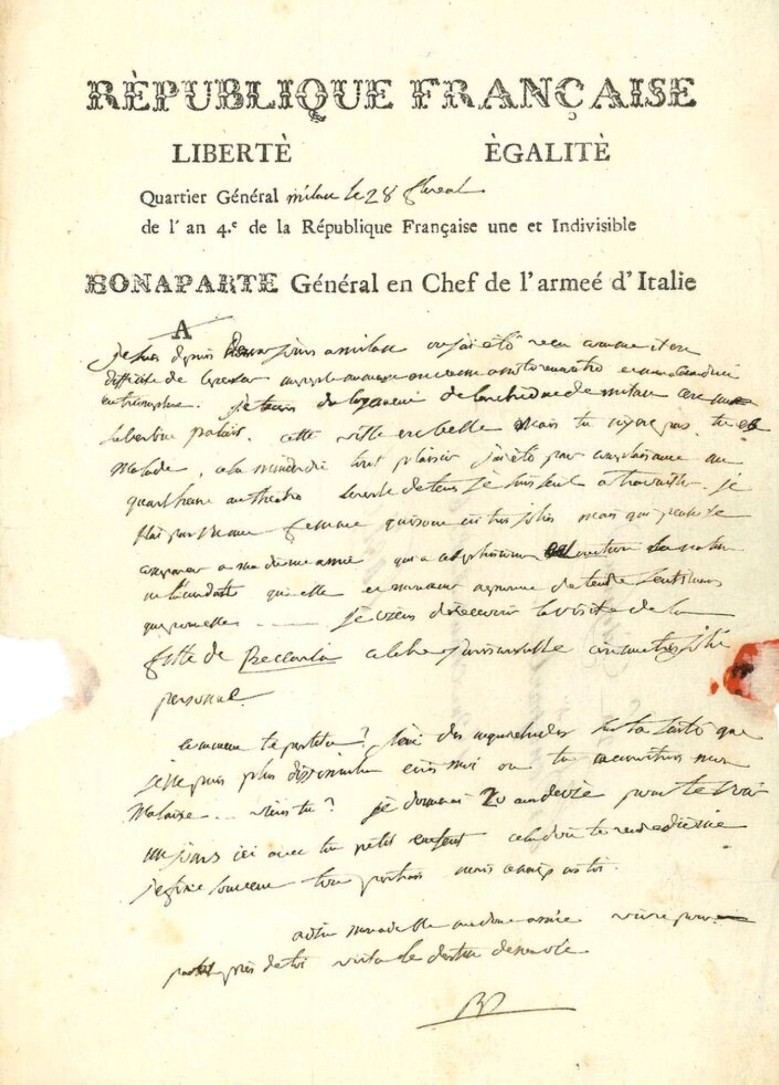

Altezza
Napoleone è famoso tra le altre cose per la sua altezza. Era alto 1 metro e 69 centimetri, circa 3 sopra la media dell’epoca e 3 in più rispetto all’ex presidente francese Sarkozy. Quella di Napoleone "formato mignon" sarebbe una maldicenza degli inglesi per sminuirne la fama sui campi di battaglia.
Inoltre Napoleno era attorniato da elementi della Guardia Imperiale e Granatieri la cui altezza era nettamente superiore a qualla dell'Imperatore.
Napoleon is famous among other things for his height. He was 1 meter and 69 centimeters tall, about 3 above the average of the period and 3 more than the former French president Sarkozy. That of Napoleon "size mignon" would be a slander of the English to diminish its fame on the battlefields.
Moreover Napoleno was surrounded by elements of the Imperial Guard and Grenadiers whose height was clearly higher than that of the Emperor.
Aquila Napoleonica
Fuse in bronzo, le aquile presenti sulla punta degli stendardi furono distribuite al Champ-de-Mars di Parigi il 5 dicembre 1804, in una cerimonia in cui il nuovo imperatore fece prestare giuramento alla sua armata. A imitazione diretta di quelle delle antiche legioni romane, Napoleone ordinò di metterle in cima all'asta delle bandiere di ognuno dei suoi reggimenti. E non c'è da stupirsi: Bonaparte era un grandissimo fan di Giulio Cesare. Lo stimava talmente come condottiero che coniò il motto: "Cesare si nasce, non si diventa", e si paragonava spesso a lui e alle gesta dei grandi conquistatori romani per esaltare le sue imprese. Adottare i simboli della Roma Imperiale, come l'aquila di bronzo, era quindi un modo per rinverdirne i fasti. Con Napoleone, Parigi diventò "caput mundi". Come lo era stato l'Urbe.
Cast in bronze, the eagles on the tip of the banners were distributed to the Champ-de-Mars of Paris on December 5, 1804, in a ceremony in which the new emperor made his army take an oath. In direct imitation of those of the ancient Roman legions, Napoleon ordered to put them at the auction of the flags of each of his regiments. And no wonder: Bonaparte was a huge fan of Julius Caesar. He esteemed him so much as a condottiere who coined the motto: "Caesar is born, not made", and often compared himself to him and to the deeds of the great Roman conquerors to exalt his exploits. Adopting the symbols of Imperial Rome, like the bronze eagle, was therefore a way to revive its splendor. With Napoleon, Paris became "caput mundi". How the Urbe had been.
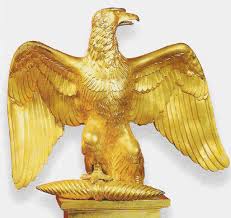

Austerlitz (notte prima della battaglia)
La notte prima della famosa battaglia (1° Dicembre 1805), Napoleone accompagnato da alcuni ufficiali, da un drappello di cacciatori a cavallo e dal suo chirurgo, eseguono l’ultima perlustrazione del campo. Tornando verso la sua tenda passa attraverso gli accampamenti dei suoi soldati che lo riconoscono e lo festeggiano calorosamente. Napoleone anche a Sant’Elena ricorderà quel momento come il più bello della sua vita.
The night before the famous battle (1 December 1805), Napoleon accompanied by some officers, a group of hunters on horseback and his surgeon, carry out the last patrol of the camp. Returning to his tent he passes through the camps of his soldiers who recognize him and celebrate him warmly. Napoleon also in Sant 'Elena will remember that moment as the most beautiful of his life.
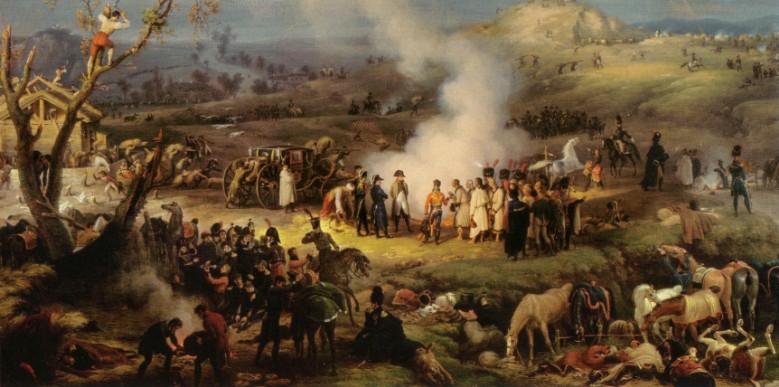

Banca di Francia
Per controllare le finanze e regolare il credito, nel 1800 ha creato la Banca di Francia. La nostra Banca Centrale Europea ne è l’erede diretta.
To monitor the finances and check the credit he created the Bank of France. Our Erupoean Central Bank is its direct heir.

Biografie
Sono stati scritti più di 70.000 libri su Napoleone, in diverse lingue, più di quanto siano i giorni trascorsi dalla sua morte.
There are over 70.000 books about Napoleon, in any language, an impressive number bigger than the days that passed since his death.

Bonaparte o Buonaparte?
Il padre di Napoleone si chiamava Carlo Maria Buonaparte. Cambiò il cognome in “Bonaparte” dopo la sua morte, pochi giorni prima di sposare Giuseppina e partire per la campagna d’Italia, per renderlo più adatto alla lingua francese.
Napoleon's father was named Carlo Maria Buonaparte. He changed his surname to "Bonaparte" after his death, a few days before marrying Giuseppina and leaving for the Italian campaign, to make it more suited to the French language.

Caduta e morte
Grazie al corso della storia e alle sue qualità personali, il figlio di un modesto nobile della Corsica divenne in pochi anni il sovrano più potente d'Europa.
I suoi dodici anni di regno hanno segnato il continente in modo indelebile.
La caduta dell'Imperatore è il seguito straziante della sua folgorante ascesa: un'epoca tragica segnata da molte zone d'ombra, fonte di ispirazione per molti artisti.
Thanks to the course of history and his personal qualities, the son of a modest noble of Corsica in a few years became the most powerful ruler in Europe.
His twelve years of reign marked the continent indelibly.
The fall of the Emperor is the harrowing continuation of his dazzling ascent: a tragic era marked by many shady areas, a source of inspiration for many artists.
His twelve years of reign marked the continent indelibly.
The fall of the Emperor is the harrowing continuation of his dazzling ascent: a tragic era marked by many shady areas, a source of inspiration for many artists.

Cappello bicorno
All'asta il cappello bicorno di Napoleone Bonaparte ed altri mille oggetti che fanno parte della collezione napoleonica raccolta dal Principe Luigi II. Nonostante il feltro del copricapo sia decisamente consumato e alterato per l'età, gli organizzatori sperano di recuperare dalla vendita almeno 500 mila euro (623 mila dollari). L'appuntamento per l'asta è a Fontainebleau il prossimo 15 e 16 novembre, dove oltre al celebre berretto ci saranno due lettere scritte a mano dall'imperatore, un fucile, un busto in marmo bianco, un'aquila di bronzo e la maschera mortuaria del rivoluzionario francese.
At the auction the bicorn hat by Napoleon Bonaparte and a thousand other objects that are part of the Napoleonic collection collected by Prince Louis II. Although the felt of the headgear is definitely worn and altered due to age, the organizers hope to recover at least 500 thousand euros (623 thousand dollars) from the sale. The appointment for the auction is in Fontainebleau on 15 and 16 November, where in addition to the famous cap there will be two letters handwritten by the emperor, a rifle, a bust in white marble, a bronze eagle and the mask mortuary of the French revolutionary.
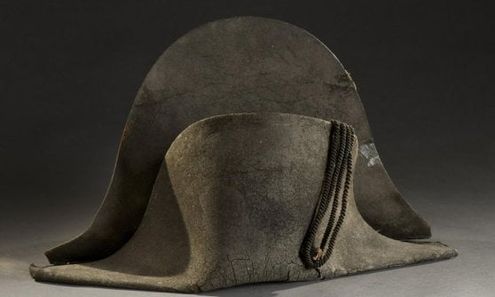

Caricature
Numerosi politici, in diverse parti del mondo, hanno avuto delle caricature ispirate a Napoleone.
Many politicians, all over the world, at the some point had a comic caricature inspired by Napoleon.
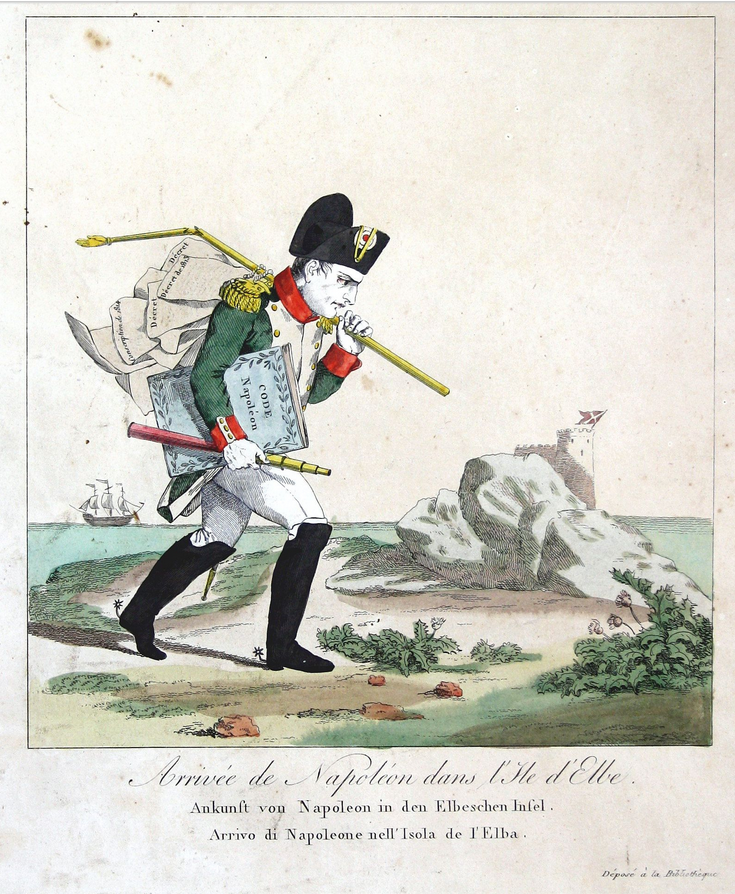

Catasto
Nel 1791, l'Assemblea Costituente abolisce le imposte ineguali e stabilisce che l'imposta fondiaria sia "ripartita per uguaglianza proporzionale su tutte le proprietà fondiarie in base al relativo reddito netto". L'ufficio del catasto nasce ufficialmente il 5 ottobre 1791, anche se le modalità di questo progetto sono state discusse per molti anni a seguire.
La legge del 15 settembre 1807 istituisce il catasto parcellare francese, denominato Catasto napoleonico, in un progetto durato oltre 30 anni.
Il Catasto napoleonico è rimasto in vigore per oltre un secolo ai fini della determinazione delle imposte fondiarie.
E' stato rivisto nel 1930 e nel 1970.
La digitalizzazione del catasto è iniziata nel 1990 per consentire un rapido aggiornamento.
In 1791, the Constituent Assembly abolishes unequal taxes and establishes that the land tax is "divided by proportional equality on all landed properties based on the relative net income". The cadastre office was officially born on October 5, 1791, although the modalities of this project were discussed for many years to follow.
The law of September 15, 1807 establishes the French parcel cadastre, called Napoleonic Cadastre, in a project that lasted over 30 years.
The Napoleonic Land Registry has remained in force for over a century for the purpose of determining land taxes.
It was revised in 1930 and 1970.
The digitalization of the cadastre began in 1990 to allow a rapid update.
The law of September 15, 1807 establishes the French parcel cadastre, called Napoleonic Cadastre, in a project that lasted over 30 years.
The Napoleonic Land Registry has remained in force for over a century for the purpose of determining land taxes.
It was revised in 1930 and 1970.
The digitalization of the cadastre began in 1990 to allow a rapid update.

Churchill
Sir Winston Churchill, un grande ammiratore di Napoleone, ha voluto scrivere una biografia documentandosi a fondo.
Sir Winston Churchill, a great admirer of Napoleon, took on the task of writing a biography about him and gathered a lot of material.

Cibo in scatola
Pochi forse sanno che è stato il grande Napoleone Bonaparte a favorire l’invenzione del cibo in scatola, nel mese di giugno del 1810, tramite un concorso da lui indetto per creare un sistema adatto a conservare i cibi da portare nelle campagne militari. A vincerlo fu il cuoco Nicholas Appert il quale, pur non conoscendo nulla di microbiologia (scienza che oltretutto a quel tempo non esisteva), sigilla il cibo in una scatoletta dopo averlo riscaldato a temperatura elevata e avere eliminato l’aria. Sarà Osterhoudt nel 1866 a brevettare la scatoletta con la chiave per aprire comodamente la confezione.
Few perhaps know that it was the great Napoleon Bonaparte who favored the invention of canned food, in the month of June 1810, through a competition he announced to create a system suitable for preserving food to be carried in military campaigns. The winner was the cook Nicholas Appert who, although he knew nothing about microbiology (a science that at that time did not exist), sealed the food in a small box after heating it to high temperature and eliminating the air. Osterhoudt in 1866 will patent the box with the key to conveniently open the package.

Cina
La prima biografia di Napoleone fu pubblicata in Cina nel 1828.
Napoleon’s first biography was written in China in 1828.

Citazioni
Le citazioni di Napoleone sono presenti ovunque nella letteratura mondiale.
Napoleon’s quotes can be found anywhere in world literature.

Codice Civile
Ci si sposa, si divorzia, si acquista una casa o si diventa cittadino italiano grazie al Codice Civile. Fu Napoleone a crearlo nel 1804. Questa notevole opera legislativa è ben presente nella nostra vita da più di duecento anni. Il Codice andò a toccare anche le regole per la successione imponendo che una parte delle eredità dovesse essere divisa in modo uguale tra i discendenti. Napoleone però volle che nel Codice la donna risultasse totalmente sottomessa all’uomo al quale doveva assoluta obbedienza: non poteva ad esempio sottoscrivere un contratto o avviare un’azione autonomamente. Le controversie tra coniugi potevano tuttavia essere risolte col divorzio (al quale non si fece gran ricorso, almeno in Italia), purché chiesto consensualmente.
We get married, get divorced, buy a house or become an Italian citizen thanks to the Civil Code. It was Napoleon who created it in 1804. This remarkable piece of legislation has been present in our lives for more than two hundred years. The Code also touched on the rules for succession, requiring that a part of the inheritance should be divided equally among the descendants. Napoleon, however, wanted the woman to be totally submissive to the man in the Code, to whom he owed absolute obedience: for example, he could not sign a contract or initiate an autonomous action. However, disputes between spouses could be resolved by divorce (which was not widely used, at least in Italy), as long as they were requested by mutual consent.
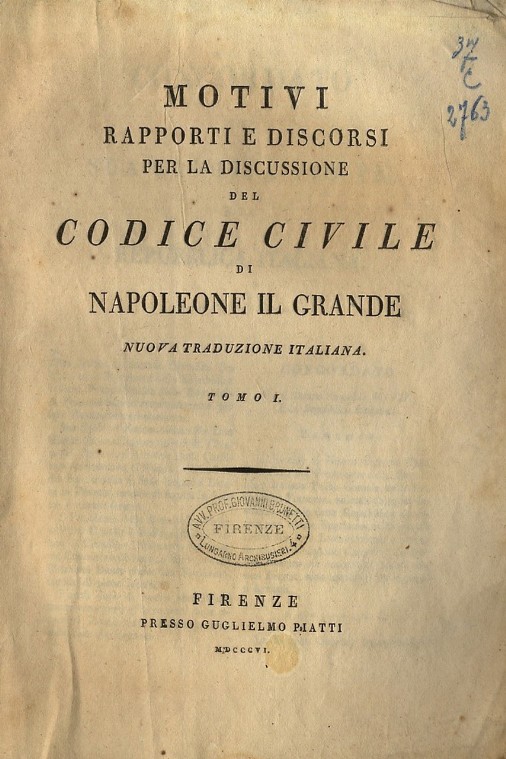

Consiglio di Stato
Sebbene Napoleone voglia una Stato forte, non vuole però uno Stato arbitrario. Ogni cittadino deve essere in grado di difendersi contro di esso. Viene creato il Consiglio di Stato, giudice dello Stato, ma anche redattore di leggi.
Although Napoleon wants a strong State, however, he doesn’t want arbitrary state. All citizens must able to defend themselves against it. The Council of State it thus established, it’s the State court, but it is also a Law editor.

Copricapo ... profilo ... atteggiamento
Napoleone portava un cappello nero, disadorno e senza doratura. Allo stesso modo, quando era sul campo di battaglia, indossava una semplice redingote grigia. Napoleone era l'immagine della sobrietà in un'epoca in cui gli ufficiali avevanp spesso un aspetto molto vistoso!
Il più delle volte, l'Imperatore manteneva questa sobrietà anche fuori dal campo di battaglia.
Tutta la grandezza dell'immagine di Napoleone risiede proprio nel suo atteggiamento, nell'intelligenza che lascia trasparire, nella sua capacità di decidere e nella forte empatia con il popolo e l'esercito.
Napoleon wore a black hat, unadorned and without gilding. Likewise, when he was on the battlefield, he wore a simple gray frock coat. Napoleon was the image of sobriety in a time when officers often looked very flashy!
Most of the time, the Emperor maintained this sobriety even off the battlefield.
All the greatness of Napoleon's image resides precisely in his attitude, in his intelligence that reveals himself, in his ability to decide and in his strong empathy with the people and the army.
Most of the time, the Emperor maintained this sobriety even off the battlefield.
All the greatness of Napoleon's image resides precisely in his attitude, in his intelligence that reveals himself, in his ability to decide and in his strong empathy with the people and the army.

Costruzione di un'immagine
Il cappello bicorno allineato alle spalle, l'uniforme, la mano nascosta nel panciotto e una gamba in avanti... Napoleone Bonaparte nei giardini del Castello della Malmaison. Quando Jean-Baptiste Isabey realizzò questo ritratto del Primo Console (1801) mai avrebbe immaginato di inscenare tutti gli elementi caratteristici dell'immagine più celebre del mondo. Dopo di lui, pochi pittori avranno l'occasione di ritrarre Napoleone dal vivo e molti si ispireranno a questa rappresentazione per creare le loro opere.
Questa effigie, parte di una comunicazione orchestrata da Napoleone Bonaparte fin dalla campagna d'Italia che assunse gradualmente un posto predominante nell'iconografia imperiale sia attraverso le commesse agli artisti di fama che alle immagini diffuse in pubblico.
The bicorn hat aligned at the shoulders, the uniform, the hand hidden in the waistcoat and a leg forward. Napoleon Bonaparte in the gardens of the Malmaison Castle. When Jean-Baptiste Isabey made this portrait of the First Consul (1801) he never imagined he would stage all the characteristic elements of the most famous image in the world. After him, few painters will have the opportunity to portray Napoleon live and many will be inspired by this representation to create their works.
This effigy, part of a communication orchestrated by Napoleon Bonaparte since the Italian countryside which gradually assumed a predominant place in imperial iconography both through orders to renowned artists and to images disseminated in public.

Diffusione di un'immagine
Oltre ai grandi quadri commissionati agli artisti. lo sviluppo dell'iconografia napoleonica benefica dei progressi tecnici dell'impero fino alla Terza Repubblica. Queste rappresentazioni riprendono la figura caratteristica di Napoleone moltiplicando i motivi ironici e le semplificazioni e forzando il tratto per trasmettere un messaggio complesso sull'Imperatore.
In addition to large paintings commissioned to artists. the development of the Napoleonic iconography of the empire's technical progress up to the Third Republic. These representations take up the characteristic figure of Napoleon, multiplying the ironic motifs and simplifications and forcing the trait to convey a complex message about the Emperor.

Divisa della battaglia
La sera prima della battaglia gli ufficiali indossano delle uniformi bellissime, con le piume, ogni tanto un mantello si apre e si vedono tutte queste decorazioni e questi alamari, questo luccichio d’oro … sono ufficiali che si preparano per la battaglia e non avranno tempo il giorno dopo per cercare l’uniforme buona, l’hanno già indossata. Per la battaglia ci si veste bene perché i soldati hanno bisogno di riconoscere gli ufficiali, e il loro prestigio è anche legato a come sono vestiti.
The evening before the battle the officers wear beautiful uniforms, with feathers, every so often a cloak opens and you see all these decorations and these frogs, this golden shimmer ... they are officers who are preparing for battle and will have no time the next day to look for the good uniform, they have already worn it. For the battle you dress well because the soldiers need to recognize the officers, and their prestige is also related to how they are dressed.
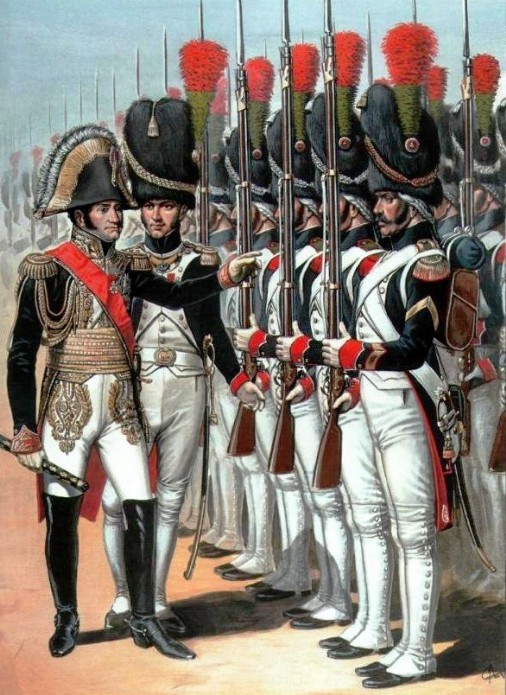

Euro
Per facilitare gli scambi economici, nel 1802 istituì il franco germinale e in seguito lo impose in Europa. È l’antenato dell’Euro.
To facilitate economic exchanges, he established the franc germinal and later he imposed it in Europe. It is the ancestor of the Euro currency.



